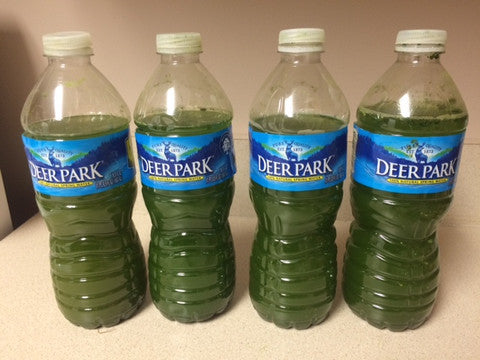If you’ve never tried matcha before, you probably have a few questions about it. You might wonder what it tastes like or how to prepare it.
You’re probably also wondering if Magus Brands matcha is as awesome as it sounds. There’s a lot of competition in the matcha market, so is Magus truly the best?
I’m going to answer all of these questions with a matcha shootout.
First, a bit about me. I’m Ian, the content guy at Magus Brands. And even though I’ve been with Magus for several months now, I'd only tried matcha once. That made me the perfect guinea pig to conduct a blind matcha shootout.
This shootout was my second ever experience with matcha, so these results are from the perspective of someone completely new to matcha. And I kept everything blind––my girlfriend helped make sure I had no idea which matcha was which until after the shootout. (She also took all of the photos for this shootout.)
There were some pretty high stakes, as I had no idea if Magus would emerge as the winner or if it would fall behind the others. I tested a pouch of premium Magus Brands matcha along with three of its highest-ranking competitors: DoMatcha, Aiya, and Kenko. Then, I got to brewing, following our official brew guide. It was a wonderful experience, and I’m pleased to share the results with you.
Before I get into the article proper, I want to make one statement: Since I’d only had matcha once before this, my results are from the perspective of a first-time drinker (that is, a first-time in-depth drinker). Those of you with more refined palates may find different tasting notes or hints of bitterness. What follows is my personal first-time experience conducted as a 100% blind taste test.
My Shootout Guidelines
Before I get into the results, here were the exact parameters I used.
I brewed three ways: usucha, koicha, and chilled in a 16.9 fl. oz. water bottle. For the hot brews, I used 167º F (75º C) water. I used 70ml water and 2g of powder for usucha, and I used 40ml of water and 4g of powder for koicha. For the cold method, I used 2g of powder. I used water filtered through my Brita pitcher for the warm brews and Deer Park brand bottled water for the cold brewing methods.
First, I evaluated the look of the tea for its color. Then, I took 3-4 sips of each tea, carefully evaluating each sample for elements like taste, mouthfeel, body, acidity, etc. I then rinsed my palate and the bowl in between tastings to eliminate residual flavors.
I used a whisk and scoop set from BambooMN. I was impressed by the quality of the set, and it helped me make some great, frothy cups of matcha. I also used a matcha sifter to make sure I got clump-free cups.
Each brewing method gave me a new perspective, and the samples were rearranged every time I tasted. So Sample 1 from the usucha brewing wasn’t Sample 1 for the koicha brewing. It was completely blind, so there is no bias whatsoever in this test.
I considered four key factors while cupping: smell, color, taste, and overall impression. I didn’t use a rating system; instead, I reflected on the experiences I had and used those to declare an overall winner in each category.
So without further ado, here are the results for each brewing method! Oh, and here’s another surprise: I’m keeping the sample identities secret until the end of the post, so read along if you want the winners to be a surprise. Or scroll down and spoil the ending; it’s your choice!
(And if you want to join in the cupping, feel free to taste test it yourself.)
Round 1: Usucha
For the first round, I prepared the matcha as usucha, which translates to “thin tea.” I followed the brew guide to make sure each cup was frothy and full of small bubbles (no big bubbles).
Sample #1
Color: Medium jade green
Smell: Dark, earthy
Taste: Bitterness up front, earthy flavors after
Impression: This cup immediately hit me with a huge umami taste, which then settled into a complex vegetal taste. This challenged my palate as a new matcha drinker, but it was rewarding. An intricate cup with lots going on.
Sample #2
Color: Light-medium jade green
Smell: Rich vegetable, faint umami
Taste: Pleasant umami, broiled vegetable
Impression: This cup also immediately hit me with a big umami taste, but it was a bit less bitter and more savory. It had a full mouthfeel to it, and the aftertaste was powdery (but not in a bad way). It was enjoyable, but in a different way from Sample #1.
Sample #3
Color: Medium jade green
Smell: Warm vegetal scent
Taste: Smooth vegetal, medium umami
Impression: This was a smooth cup with a less powdery, more pronounced umami taste. This tea was more on the umami end of the spectrum, and as a result, it gave a much different experience while also being complex.
Sample #4
Color: Light jade green with frothy crema
Smell: Warm, pleasant vegetables
Taste: Laid-back umami, broiled vegetables
Impression: This was the smoothest cup of the bunch. To my untrained palate, it had a rich, vegetal taste that was complemented with a smooth umami flavor. There was also a noticeable vegetal aftertaste that lingered in a pleasant way.
Round 1: Summary
Now it’s time to unmask the teas and see which one came out on top:
First place: Aiya (Sample #4)
Second place: Magus (Sample #1)
Third place: Kenko (Sample #2)
Fourth place: DoMatcha (Sample #3)
––––––––––––––––––––––––––––––––––––––––––
Round 2: Koicha
This round was more challenging to my palate because it was the stronger, thicker brewing method of koicha.
Sample #1
Color: Medium to dark jade green
Smell: Warm vegetal
Taste: Bitter umami, vegetal aftertaste
Impression: This was a strong cup of koicha. It was noticeably viscous and left a powdery taste in my mouth. Sort of one-dimensional, but not a bad dimension. Around the third sip, the vegetal tastes started appearing (noticeable snap pea pod flavors), though they were still masked by the ever-present umami. Not a bad cup at all, but a strong one.
Sample #2
Color: Medium jade green
Smell: Complex vegetal
Taste: Rich umami, stalk tastes
Impression: The first sip took me by surprise; instead of a wash of bitterness (which is typical of some matcha brewed koicha–style), I tasted a great umami upfront with the lingering taste of vegetable stalks. A good, smooth cup.
Sample #3
Color: Medium jade green
Smell: Balanced umami and vegetable
Taste: Complex broiled vegetable taste, umami in the background
Impression: This cup had a little bitterness up front, but it quickly disappeared into a dark broiled vegetable taste, leaving the umami in the background. This was a cup I didn’t fully understand; it was an enjoyable cup, but I sense that my untrained palate couldn’t pick up some of the more complex notes going on here. A smooth cup.
Sample #4
Color: Light to medium jade green
Smell: Balanced umami and vegetable
Taste: Pea pod up front, lingering umami in the aftertaste
Impression: This was a smooth, light cup of koicha that was almost sweet, with a pronounced pea taste in both the main sip and the aftertaste. The umami was present but not overwhelming, and the cup was smooth and rich.
Round 2: Results
This was a tough round to judge, and I ended up declaring a tie for third place.
First place: Magus (Sample #4)
Second place: Kenko (Sample #2)
Third place (tie): Aiya (Sample #1)
Third place (tie): DoMatcha (Sample #3)
––––––––––––––––––––––––––––––––––––––––––
Round 3: On-the-go (Cold)
For the third round, I took four chilled 16.9 fl. oz. water bottles and added 2g of matcha powder to each of the bottles. This is the on-the-go cold method we recommend for enjoying a chilled, refreshing drink that you can take anywhere.
For this round, I didn’t take smell into account since the matcha was cold and thus less aromatic. Instead, I judged solubility, since I didn't sift the matcha.
Sample #1
Color: Medium/dark jade green
Solubility: No noticeable clumps
Taste: Chilled vegetal, leafy
Impression: A good, medium weight and feel. On the matcha spectrum of tealike flavors to umami (with the ideal in the middle), this tea was more toward the tealike end. No noticeable bitterness; a smooth, enjoyable cup.
Sample #2
Color: Medium jade green
Solubility: A few clumps at the bottom
Taste: Leafy greens, stalk taste
Impression: This cup took a bit longer to absorb; the flavor was complex but not overwhelming. It was a smooth cup that also geared more toward the tealike end of the spectrum, but not as much as Sample 1. This cup was noticeably darker in taste, and it had a full aftertaste.
Sample #3
Color: Light-medium jade green
Solubility: Some clumping at the bottom
Taste: Lively, leafy vegetables
Impression: This was a memorable cup with a vivid fullness. I immediately experienced a rich vegetal taste, with warm tealike tastes coming in afterward. It ended with a slightly bitter aftertaste, but it was bitter in an umami sort of way, and not in a harsh way.
Sample #4
Color: Medium jade green
Solubility: Some clumping at the bottom
Taste: Smoky, umami
Impression: This had the most smoky taste of the bunch. It wasn’t exceptionally smooth, but its flavor was intense and felt the most concentrated. The tealike flavors arrived halfway through the sip but didn’t stay too long.
Round 3: Results
To find a winner for this category, I considered which tea would be best for a full bottle. That is, if I wanted to drink a whole bottle, which tea would it be? It was a tough decision to make, since all of these teas were quite delicate in their taste. In the end, I considered fullness of flavor and bitterness as two main factors.
Here’s what I decided:
First place: DoMatcha (Sample #1)
Second place: Magus Brands (Sample #2)
Third place: Aiya (Sample #3)
Fourth place: Kenko (Sample #2)
From left to right: DoMatcha, Magus Brands, Aiya, Kenko
––––––––––––––––––––––––––––––––––––––––––
But What About Price?
You're probably wondering how these teas stack up in price. I've calculated the price per gram for each tea:
Magus Brands: 33¢
Kenko: 99¢
Aiya: 63¢
DoMatcha: $1.11
So if you want to enjoy true ceremonial grade matcha on a budget, Magus Brands matcha can't be beat.
––––––––––––––––––––––––––––––––––––––––––
Seeing Is Believing
Here are all four matcha powders––decide for yourself which one is the brightest, most electric green:
From top to bottom: Aiya, DoMatcha, Kenko, Magus Brands
––––––––––––––––––––––––––––––––––––––––––
The Magus Advantage
At the end of the day, Magus Brands placed solidly overall. It was the best in class for the koicha method and second place in the usucha and to-go categories. I picked the top competitors who have been around for years, so Magus was taking on its biggest rivals. It speaks volumes that a new matcha company managed to do so well against its competition.
But don't take my word for it––try it yourself.














